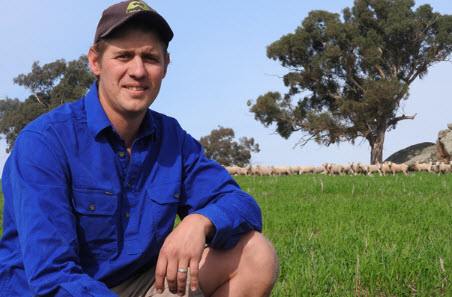Sex ratio of lambs linked to maternal nutrition
14 September 2017

Sheep producers may soon have the ability to influence the sex ratio of lambs by manipulating maternal nutrition around the time of conception, with new research indicating a sheep’s diet may influence the gender of offspring.
The research, conducted by the NSW Department of Primary Industries (NSW DPI) in collaboration with the Graham Centre at Charles Sturt University, started in 2010 and has involved more than 1500 ewes. It examines the ratio of omega-3 and omega-6 fatty acids in the diet of ewes and the effect it has on the sex ratio of lambs.
Initial research results found that feeding a diet high in omega-3 (such as pasture and silage) to ewes at joining was associated with a higher proportion of male lambs, while a diet high in omega 6 (based on oat grain) produced a higher proportion of female lambs.
On-farm trials are now being carried out by Dr Ed Clayton from the NSW DPI in conjunction with the Holbrook Landcare Network to test these findings, with funding from Meat & Livestock Australia (MLA) and Australian Wool Innovation (AWI).
MLA General Manager – Producer Consultation and Adoption, Michael Crowley, said the research is positive news for producers.
“The initial research looks promising and field trials will determine if producers can influence the sex ratio to the preferred gender to target specific production systems through changing input management," Mr Crowley said.
Dr Ed Clayton said work was being undertaken on 11 trial sites over a three year period to test the practicalities of the research on farms near Wagga Wagga and Holbrook, in southern NSW.
“We are looking at how the effect of feeding diets to unsynchronised ewes in a paddock feeding situation influences the sex ratio of the lambs, and the best sources of omega-3 and omega-6 to incorporate into practical on-farm rations,” Dr Clayton said.
The first of the on-farm trials began last year and involved five farms with a sample flock of 500 ewes split into two groups on each farm.
Half the ewes grazed on pasture alone in the lead up to joining and the other half were supplemented with 600 grams of oats per day for four weeks leading up to joining and during the first two weeks of joining, giving them six weeks of grain.
“At the farm gate, the first year of trials didn’t show a huge difference in the sex ratio of offspring on individual farms. On some farms there was a 4-5% difference in sex ratio but other producers recorded no change,” Dr Clayton said.
“However, blood samples collected from a representative sample of ewes from each treatment group found there was a correlation between the fatty acid profile in the blood and the sex ratio of lambs.
“For example, on one property where there was no difference in sex ratio between the treatment groups, there was also no difference recorded in the fatty acids in the blood between the treatment groups.
“On properties where we changed the fatty acid profile, we saw a difference in the sex ratio of lambs. This provides some evidence that if the fatty acid profile can be changed through diet, we can influence the sex ratio of offspring.”
Dr Clayton said the next two years of trial work would address some of the practical challenges of managing the feedbase and conducting un-replicated trials on-farm.
“We’ll be looking at some of the variables which are difficult to manage out in the paddock. For example, the right length of feeding leading up to joining, how much grain to feed and what type of grain to feed, as well as how to more accurately account for the normal variation seen in sex ratios between mobs and individual paddocks,” he said.
Farming Systems Project Officer with Holbrook Landcare Network, Ashley Paech, is running producer interviews alongside the on-farm trials to seek feedback on the research and its relevance for farm businesses.
“Commercial producers can definitely see value in the research particularly in a building or rebuilding phase, so after drought for example, when it’s important to build ewe numbers,” Mr Paech said.


